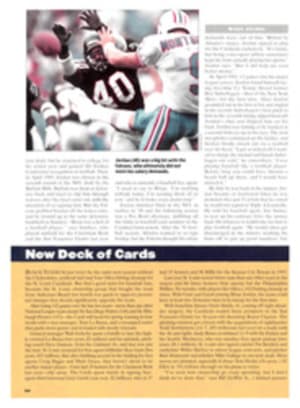
WHOLE LOTTA TALENT LISELOTTE NEUMANN FINALLY LIVED UP TO EXPECTATIONS WITH A RUNAWAY WIN IN THE LPGA'S SEASON OPENER
A new era in LPGA history officially began last week at the
Chrysler-Plymouth Tournament of Champions in Orlando. In his
first week as commissioner, Jim Ritts smoothly dealt with Ben
Wright's dismissal from CBS and Annika Sorenstam's disappointing
no-show in the tour's glitzy season-opener. Then he wisely
stepped aside and let Liselotte Neumann take over the show.
Everyone says that if Ritts is going to successfully fill the
large shoes of departing commissioner Charlie Mechem, he'll need
some stars to light the way. He already has a bright one in
Sorenstam, and last week he might have found another if Neumann,
Sorenstam's teenage idol, can duplicate the kind of dominating
performance she turned in at Grand Cypress Resort.
Lotta, as she is called on the tour, was cast as the next Nancy
Lopez when she won the 1988 U.S. Women's Open as a 22-year-old
rookie from tiny Finspang, Sweden. She became the youngest
professional to take the title and the first to go wire to wire
since Amy Alcott in 1980. Meanwhile, back in Stockholm, a
17-year-old Sorenstam, soon to enroll at Arizona on a golf
scholarship, was glued to the tube. Seven years later,
Sorenstam, too, would make the Open her first LPGA victory. She
went on to become the 1995 Player of the Year.
Of course, sustained success did not come immediately in the
wake of Neumann's Open win. Expectations were high, and there is
a feeling that Neumann has yet to live up to them--certainly not
to the degree that Sorenstam has. Other than in 1994, when she
won three times, Neumann has been considered more of an
underachiever than a world-beater. Last year she joined the rest
of the LPGA in the shadow cast by Sorenstam, who at 24 won six
tournaments on four continents, plus the money titles of both
the LPGA and European tours. But Neumann sent a strong message
last week that the LPGA is not necessarily a one Swede town.
With rounds of 67-66-72-70, she led by nine strokes after 36
holes, by eight after 54 and by as many as 12 during the final
round.
Given the way Neumann played, Sorenstam made a timely, if
unpopular, decision by choosing to pass up Orlando. "Obviously,
when you play well you get a little busier than when you don't
play well," said Neumann. "But still, she had Christmas and New
Year's to rest up, and you know you can take time off in
February. I think we all wish she was here."
In truth Sorenstam's November-December schedule was busier than
Greg Norman's. "I don't feel like I've had an off-season," said
Sorenstam, refusing to budge even when Ritts did some
arm-twisting. The best she was willing to do was promise that
she would play the T of C in 1997. Chrysler-Plymouth was not
appeased, nor was NBC, which questioned Sorenstam's decision on
the air.
So while 43 players were shaking off the rust and grinding it
out in the cold and wind on a Jack Nicklaus-designed course that
is likely to be one of the most difficult they will play all
year, Sorenstam was in Reno moving into her new house. She may
play in the Hawaiian Ladies Open in February, she may not. Her
first scheduled event is the Ping/Welch's Championship in Tucson
in March, when the LPGA's irregular winter schedule ends.
Neumann's blowout brought back memories of Sorenstam's 10-shot
win in St. Louis at last year's GHP Heartland Classic, and her
11-stroke margin of victory was only three off the LPGA record.
Neumann hit 80% of the fairways and 71% of the greens, but most
important she averaged only 27.5 putts a round. "You wish you
could bring this feeling with you wherever you're going," she
said, "but it just doesn't work that way."
The battle for the B Flight was won by Karrie Webb, an
Australian rookie who qualified by winning the Women's British
Open. She shot 68 on Sunday to finish at two under, one ahead of
Missie McGeorge and Laura Davies, who in the final round
averaged 296 yards on the two holes used to compute driving
distance. No one else broke par. Beth Daniel and Betsy King were
four over, Dottie Pepper five and Patty Sheehan eight. Neumann
finished at 13 under. "I had a hard time believing she was
playing the same golf course," said McGeorge.
Neumann geared up for the victory the same way Mark O'Meara did
before going 17 under to win the Mercedes Championships. She
went skiing, in Vail, for the first time in 12 years and wasn't
sure what type of swing she would bring to the T of C. Neumann
hadn't played since the JC Penney Classic in early December, or
touched a club--other than her putter--for three weeks. Not that a
heavy workload had made much difference in the past. Many
observers feel that Neumann has always had as much talent as
Sorenstam, but that it has been misdirected. "Over the years
she's tried to improve her swing and hit the ball a little
farther," says Mark Scott, her caddie since 1988. "Now I think
she realizes that she doesn't have to do anything except take
what she's got and work on that."
The genesis of the turnaround can be traced to last year's du
Maurier. Neumann lost by a stroke to Jenny Lidback, and the
disappointment was palpable. Three months later she won the
Australian Women's Open, defeating Sorenstam and Jane Geddes in
a playoff. Although it was Neumann's second victory of the year,
neither came in the U.S. She finished a disappointing 16th on
the LPGA money list, earning $200,000 less than in 1994.
"She wins a lot of tournaments," Davies says. "She hasn't won
that many on the LPGA, but she's won around the world and no
matter where you win a tournament, you've had a great week. I'd
expect more and more from her. She has no weaknesses, absolutely
none at all."
Well, Neumann might have one. She doesn't hit her long irons
high enough to hold many greens, so she has added a seven- and a
nine-wood to her bag. Could Lotta and her Divine Nine be showing
up soon in commercials next to Annika and her Big Bertha driver?
That's not the point, she insists.
"I'm just trying to make the game easier," Neumann says, and
after last week's performance there is little doubt that she has
succeeded.
COLOR PHOTO: PHOTOGRAPHS BY BEN VAN HOOK [Liselotte Neumann]
COLOR PHOTO: PHOTOGRAPHS BY BEN VAN HOOK Neumann's lead and the difficult layout formed a hill too steep for Davies to climb. [Laura Davies]

